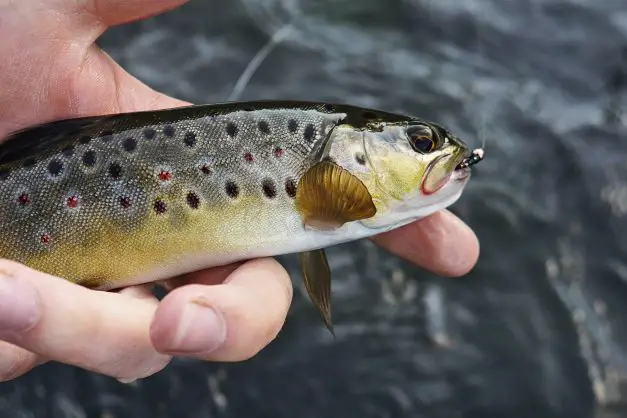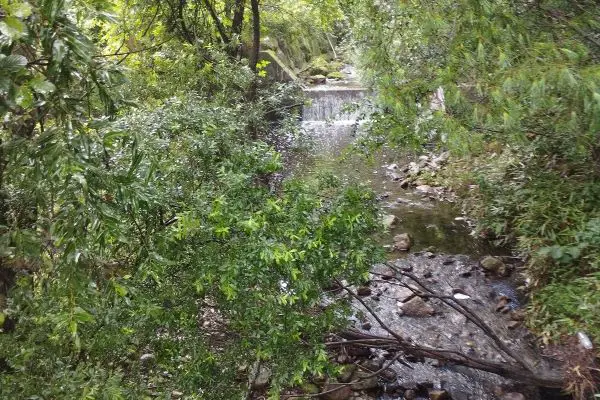It was a warm summer’s day, as I crawled up under the overhanging willow branches. Casting was impossible due to the thick vegetation. I took a glimpse over the bank, and, sighted almost within arm’s reach a large feeding brown trout.
I unhooked my fly, a size 16 pheasant tail, and slowly moved my rod tip so it was directly above her. I flicked the fly forwards, allowing it to drop, with barely a splash it hits the water and drifts down towards the feeding trout.
I saw the white flash of opening jaws and with barely two feet of leader out, I set the hook. Now the real challenge begins, how do I fight a large trout where there is nowhere to stand?
Tiny, overgrown streams can hold a surprising number of trout. Sometimes the streams are so small that they appear as only a blue line on a map. Trout in such streams can be surprisingly difficult to catch. Not because they are line shy, they are rarely fished over. No one in their right mind wants to fight through thick undergrowth to catch them.
Wherever trout live. Fishermen will follow and overgrown streams can prove to be a worthwhile adventure for the active fishermen. In this guide, I will provide 5 hints on how best to target trout in tight spaces.
1) Do not limit yourself to one method of fishing
In such streams, there is rarely enough room to cast, which makes fly fishing very difficult. Even a 7ft 3wt fly rod which is designed for such tight waters is difficult to use.
In the tightest of streams, I prefer to use a short spinning rod such as the 4’6” Shakespeare Micro Spinning Rod. It has everything I require in a tight stream rod, it is very short so good in cramp spaces. It is very cheap, so I do not have to be careful bashing through the undergrowth and as a composite rod it is surprisingly durable.
With a short spinning rod, I can still flick out a fly, or cast a small lure such as a joes fly. A long rod does not have any advantages when used in such tight surroundings.
Such streams is one place where Tenkara is potentially a better option than traditional fly fishing. This is because they can quickly and easily telescope to make them easier to carry. I have never fished Tenkara rods but consulted a friend to get some recommendations.
“The Dragontail Foxfire zx280 is the way to go for smaller streams. It is zoomable so can be fished at three different lengths 6’6’, 8ft, and 9’3”. It is flexible enough to cast well at such short lengths.”
“For a dedicated overgrown stream rod, the Tiny Ten at 4 feet 11 inches is a great bet. It does feel super stiff, making it not great for traditional casting but it is designed specifically for bow and arrow casts which it does well”
2) Practice Bow and arrow casts and Dapping
Some people insist on bringing their fly rods, or maybe it is fly fishing only water.
There are two fly fishing techniques that work well in tight spaces. These are dapping and the bow and arrow cast.
I will first discuss the art of dapping, while I know some purists will disagree, dapping shares a lot in common with Tenkara. Dapping involves presenting the fly to the trout using just the leader, often there are only two or three feet of leader out of the guides.
Simply present the fly by dropping it onto the water. There is no casting involved. Most dapping is done with dry flies, although a variation of the technique also works with nymphs.
The Bow and Arrow cast can be used to cast a fly line a few yards when there is not enough space for a proper cast. Start with 5 or 6ft of fly line out of the guides, then grip the fly line with two fingers just above the rod handle. Pull back the fly line which loads the rod like a bow ready to fire an arrow. Then release the fly line and the built up inertia should be enough to carry the fly line and tippet a few yards out onto the water.
If my description is too vague to follow, here is an Orvis tutorial that shows how it is done.
3) Winter and early spring are a great time to fish overgrown streams
During the winter, most of the annual plants die and the deciduous plants lose their leaves which can make the streams much easier to follow.
This makes winter and spring some of the best times to fish such streams. Sometimes the snow can even assists by burying the undergrowth.
Just be careful to avoid disturbing spawning rainbow or cutthroat trout which typically spawn early in the spring.

4) Bring hand pruners or even a small machete.
Garden equipment is not typically carried by fishermen, but it can come in handy while bashing up overgrown streams. While I am not advocating cutting back native vegetation, there are plenty of weeds that can benefit from a haircut to make it possible to fish further upstream.
The creeping vines and branches of invasive weeds such as old man’s beard, Himalayan balsam, Japanese knotweed, or wild blackberry can make walking slow. Blackberry in particular has a tendency to wrap around my legs and tangle me up. A few snips with hand pruners and they are no longer a problem.
Machetes are a good option for even thicker infestations. Some people carry small silky saws to cut through overhanging branches and windfall, although using them in some streams can be seen as a bit more controversial.
5) Avoid the dark tunnels, trout prefer dappled light
I am keen to hear about other people experiences in this regard, but I rarely catch trout from the darkest most overgrown sections of a stream. Places where the canopy is so dense and thick, that water weeds struggle to grow. While I suspect trout might use such areas to rest or for bolt holes, I do not believe they actually feed there.
This is because there is simply not enough aquatic life in such areas for trout to meet a trout’s energy requirements. The main exception is during the summer when the trout are feeding on terrestrials that can drop down from the trees above.
I catch the majority of my trout in areas of the stream which receive some sunlight which certainly increases the amount of aquatic life. Dappled light is good, or even completely open. While I catch trout in such areas, it does not mean the trout are feeding out in direct sunlight, but they are usually hiding between weed patches or hard against an undercut bank or beneath overhanging vegetation. The trout will drift out to intercept any food drifting downstream.
6) Stealth is as important as ever
It might be tempting to think, trout up nearly impenetrable streams will be less wary of people. When in reality, the opposite is generally true, doubly so because trout in such streams are normally in very shallow water, making them on edge.
Secondarily, we usually have to get very close to the trout before casting, which increases the chance of them becoming aware of our presence.
Moving stealthily, and blending into the environment is as important as ever. I advise using the surroundings to your advantage, try and hide behind plants, weeds, or anything which will provide cover.
It is okay to walk in the stream itself, but that will spook any trout which are downstream.
Summary
These were my 6 hints on how to fish overgrown streams. It is important to use short rods, be stealthy and be prepared to cast in limited spaces. At times you might even have to do some gardening.
As for the question, how to fight a trout when there is nowhere to stand? Will, there is always a way, adrenaline will kick in and you just have to adapt to the space available, even if it does mean belly rolling down a ferny bank into knee-deep water.
Feel free to share any stories, experiences, or advice in the comments below.


Thank you for the tips.I believe you are spot on.Last weekend I went to my favorite area to trout fish.The water was very low, but after 2 or 3 cool nights, I thought the trout might be more active.I went to a hole where 2 fly fisherman just left.I too love my Shakespeare micro elite rod.I casted a salted minnow on a 1/16 ounce jighead and bam.A nice 12″ brown trout.A few .inutes later, another a little bigger.I moved upstream a little and got a 3 pound brown trout.All on my 4’6″ ultra light rod.What fight the trout had in them!All were released in perfect health.
Well done, sounds like you had a great day. These little rods are great fun on tight streams.
When necessary I will take my rod apart in the middle and just cast with the tip. Works in a pinch
Thanks for the suggestion. I have never thought of trying that, I might practice a bit by casting with just the tip to see how it goes.